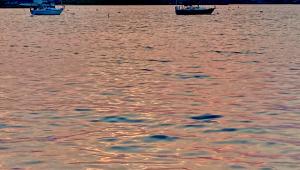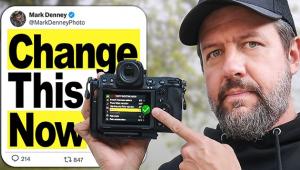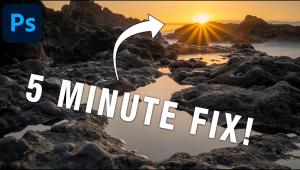Digital Help
Q&A For Digital Photography
Digital Help is designed to aid you in getting the most from your digital photography, printing, scanning, and image creation. Each month, David Brooks provides solutions to problems you might encounter with matters such as color calibration and management, digital printer and scanner settings, and working with digital photographic images with many different kinds of cameras and software. All questions sent to him will be answered with the most appropriate information he can access and provide. However, not all questions and answers will appear in this department. Readers can send questions to David Brooks addressed to Shutterbug magazine, through the Shutterbug website (www.shutterbug.com), directly via e-mail to: editorial@shutterbug.com or goofotografx@gmail.com or by US Mail to: David Brooks, PO Box 2830, Lompoc, CA 93438.
Minolta Lives On Under The Sony Banner
Q. Could you help me out? I have a Minolta Maxxum 400si SLR and a few lenses
to go with it. I would like to go digital, but I don't want to replace
all of my lenses. Is there a digital body that will accept my lenses?
via e-mail
A. Minolta's photo division was taken over by the Sony Corporation sometime ago. The Sony Alpha A100 and A700 D-SLRs are compatible with recent Minolta 35mm SLR lenses. In addition, I think you will find the Sony D-SLRs are some of the best in performance for very reasonable and competitive prices. For more information read the review of the Sony Alpha A700 in the January 2008 issue of Shutterbug or go to the Sony website at www.sonystyle.com.
A Leica Compatibility Question
Q. I have a Leica R7 and five lenses. Re: the Leica Digilux 3, is this a 5-megapixel
resolution body or a 7.5-megapixel as stated by Leica? Several camera stores
state the megapixels at 5.0, not 7.5. Also, Leica says that this body will accept
the lenses that I use on my Leica R7.
Ed Blackman
A. The Leica Digilux 3, according to my calculation based on the pixel dimensions quoted on the Leica website, has a 7.38-megapixel sensor chip. It also has a Four Thirds' bayonet lens mount that I must assume will not accept 35mm Leica R-mount lenses.
JPEG May Not Be That Universal
Q. I recently purchased Nikon's Capture NX. Since installing the software,
every time I try to upload an image to my page on OneModelPlace.com they reject
the image, claiming it is not saved as a JPEG. I was able to upload images before
installing Capture NX with no trouble. I can upload images from computers not
equipped with Capture NX with no problem. I know I'm saving the images
as JPEGs. I have even saved the images in Photoshop as a JPEG after working
on them in Capture NX, but the images are still rejected as "not saved
as JPEG." Any ideas on how I can solve this?
Bill Wolf
A. Although JPEG is an international standard file format,
the standard allows application programmers, as well as camera makers, to add
and modify their implementation of JPEG in the way .JPG files are generated.
Every brand exercises a certain amount of programming arrogance, thinking their
version of JPEG will be better for the users than someone else's. To some
extent those modifications can cause some applications to not recognize and
open those .JPG files.
There is a possible strategy that may work to get around this problem. Instead
of setting Capture NX to output JPEG format files, set it to output TIFF files.
Then open these TIFF files in Photoshop and use Save As to generate a new
JPEG file.
Tropical Hazards
Q. I need help to determine the root cause of a problem that just occurred with
my digital camera. I recently returned from a cruise and when I downloaded my
pictures from my memory card to my computer, I was shocked to find many pictures
were covered by a black area or a yellow/green area. When you view the pictures
on the camera's monitor or as thumbnails from the memory card on the computer
they seem to be in good order. However, when you download the pictures to the
computer, some of the thumbnails and the opened pictures are partially covered
by a black or sometimes colored area. Not all the pictures have this problem.
I calculated 17 percent had this phenomenon.
I've taken thousands of pictures and never had this problem before. Any
advice you can offer would be appreciated.
Ken Brook
A. From what you report and your sample images, my first guess
would be that your camera is functioning OK internally, but that the data path
to recover the files has a problem, caused very likely by poor quality contacts
with the media at some point. If the images all play back using your camera's
LCD screen without any anomalies, then the interface you are using for downloading
the files has some problems. Having been in the tropics it just may be the humidity
has corroded or added fungus to the contacts between card, camera, and whatever
download device you are using. You can use electronic contact cleaner and try
to establish better contacts between the card and camera as well as the card
reader and card.
If you don't trust doing this yourself, get a reputable independent Nikon
authorized service station to clean all of the contacts and use their facilities
to recover the files from the memory card(s) and put them on a CD for you. And
if you want to be super sure, once you have retrieved clean images from the
card, trash that card and replace it with a new one.
Tropical climates with high humidity and lots of fungus have always been deadly
to most consumer cameras, excepting the few professional models that have
airtight seals.
Using Third-Party Electronic Flash
Q. I recently purchased a Nikon D200 and also have a (less than a year old)
Sunpak 622 flash. What do I need for these two to work together, or is it possible?
I have asked others, including camera repair techs, and always get different
answers. I have also attempted to contact Sunpak by US mail and their website/e-mail
with no response. Nikon only recommends their flashes.
Jeff Yancey
A. If there is a TTL module made by Sunpak that is specifically
made for your new Nikon D200, then that is what you need to obtain automatic
flash exposure control using the Sunpak 622 with your camera. I, too, have attempted
to contact ToCAD America, which is the distributor for Sunpak, but have not
obtained a response.
However, both Adorama (www.adorama.com) and B&H (www.bhphotovideo.com) are
Sunpak dealers and if a TTL module for your camera for use with the Sunpak 622
is available, one or the other is probably the most likely source.
I am not entirely familiar with the Sunpak 622, but assume it is capable of
semiautomatic output control using a particular f/stop for a specific ISO setting.
All you would need to do is set the Nikon on manual at sync shutter speed and
the chosen f/stop, then connect the flash for firing by the sync, either a universal
hot shoe or PC connector. I would suggest referring to the manual that came
with the Sunpak 622 for more information.
ANNOUNCEMENT
I am pleased to announce a new Third Edition adding five chapters to my eBook
DIGITAL DARKROOM RESOURCE CD. The CD now contains 26 chapters totaling 318 pages
in Adobe Acrobat .PDF format, providing easy-to-read text and large high-quality
illustration. The CD is available for $20 plus $4 shipping and handling (US
Mail if available). Ordering is as simple as sending a check or money order
for $24 made out to me, David B. Brooks, and mailed to PO Box 2830, Lompoc,
CA 93438.


































